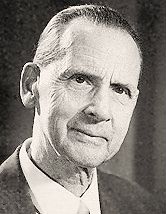The contrabassoon, also known as the double bassoon, is a larger version of the bassoon, sounding an octave lower. Its technique is similar to its smaller cousin, with a few notable differences.
The heckelphone is a musical instrument invented by Wilhelm Heckel and his sons. The idea to create the instrument was initiated by Richard Wagner, who suggested its concept at the occasion of a visit of Wilhelm Heckel in 1879. Introduced in 1904, it is similar to the oboe but, like the bass oboe, pitched an octave lower, the heckelphone has a significantly larger bore.

William Waterhouse was an English bassoonist and musicologist. He played with notable orchestras, was a member of the Melos Ensemble, professor at the Royal Northern College of Music, author of the Yehudi Menuhin Music Guide "Bassoon", of The New Langwill Index, and contributor to the New Grove Dictionary of Music and Musicians.
Carl Maria von Weber's Concerto for Bassoon in F Major, Op. 75 was composed in 1811 for Munich court musician Georg Friedrich Brandt, was premiered on December 28, 1811, and then revised in 1822. Primarily an opera conductor and composer, Weber had only arrived a few months earlier in Munich, where he was extremely well received. The concerto is one of two pieces written for bassoon by Weber, the other being Andante e Rondo Ungarese, Op. 35. A typical performance lasts 18–20 minutes.
The Octet in E-flat major by Ludwig van Beethoven, Op. 103, is a work for two oboes, two clarinets, two bassoons, and two horns. Beethoven wrote the work in 1792 in Bonn before he established himself in Vienna. He reworked and expanded the Octet in 1795 as his first String Quintet, Op. 4. The Octet was not published until 1834 by Artaria, thus explaining the high opus number despite its date of composition.

Graham Waterhouse is an English composer and cellist who specializes in chamber music. He has composed a cello concerto, Three Pieces for Solo Cello and Variations for Cello Solo for his own instrument, and string quartets and compositions that juxtapose a quartet with a solo instrument, including Piccolo Quintet, Bassoon Quintet and the piano quintet Rhapsodie Macabre. He has set poetry for speaking voice and cello, such as Der Handschuh, and has written song cycles. His compositions reflect the individual capacity and character of players and instruments, from the piccolo to the contrabassoon.

Gestural Variations, Op. 43, is a trio composition by Graham Waterhouse in 1997 originally for oboe, bassoon and piano. Later versions are scored for clarinet, cello and piano (1999) and flute, cello and piano (2009).
Jens Josef is a German composer of classical music, a flutist and academic teacher.

The Bassoon Quintet is a quintet by Graham Waterhouse, composed in 2003 for bassoon and string quartet.
Lyndon Jeffrey Frank Watts is an Australian bassoonist. He is principal bassoonist of the Münchner Philharmoniker and an academic teacher.

Epitaphium is a composition for string trio by Graham Waterhouse. In 2007, after the death of his father William Waterhouse, he composed Epitaphium in Memoriam W.R.W. as a tribute to his memory.
Julie Price is an English bassoonist. She is principal bassoonist of the BBC Symphony Orchestra.

Der Handschuh is a composition by Graham Waterhouse. He wrote the setting of Friedrich Schiller's ballad for cello and speaking voice in 2005. It was published in 2007 in Heinrichshofen's Verlag.

Victor Bruns was a German composer and bassoonist. He played with the Leningrad Opera, the Volksoper Berlin and the Staatskapelle Berlin. As a composer, he is known for his ballets and for bassoon concertos and sonatas.

Mouvements d'Harmonie op. 29 is a composition in one movement for wind ensemble, written by Graham Waterhouse in 1991, dedicated to William Waterhouse. It was first performed on 24 May 1991 in the Purcell Room, London. The piece was published in 2000 by Accolade, Holzhausen. It was recorded by Endymion in 2002 on a composer portrait CD.

Graham Waterhouse, cellist and composer especially of chamber music, has written a number of works for string quartet, three major works in several movements, several smaller works and compositions for a solo instrument and string quartet.
Ronald James Klimko was an American bassoonist, author, composer, teacher, and performer.

Phoenix Arising is a composition for bassoon and piano by Graham Waterhouse, who wrote it in 2008 in memory of his father, the bassoonist and musicologist William Waterhouse. It premiered in London in 2009, and was published by Accolade the same year.
Elisabeth Waterhouse is an English pianist and music pedagogue. She founded the National Chamber Music Course, a summer school for young string players, in 1974, and has managed it since. She is the widow of the bassoonist and musicologist William Waterhouse.



